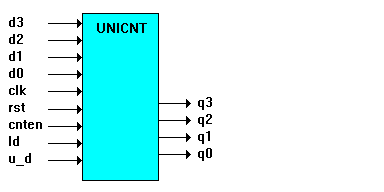The following design illustrates the implementation of a 4-bit up/down counter with parallel load and count enable. The design is described using high-level ABEL-HDL equations. The following figure shows the block diagram of the counter.

The outputs q3, q2, q1, and q0 contain the current count. The least significant bit (LSB) is q0.
Using Sets to Create Modes
The counter has four modes of operation:
![]() Load data from the inputs.
Load data from the inputs.
![]() Count up.
Count up.
![]() Count down.
Count down.
![]() Hold count.
Hold count.
You select the modes by applying various combinations of values to the inputs cnten, ld, and u_d, as described below. The four modes have different priorities, which are defined in the ABEL-HDL description.
Load Mode - Has the highest priority. If the ld input is high, then the q outputs reflect the value on the d inputs after the next clock edge.
Hold Mode - Has the second highest priority. If ld is low, then when the cnten input is low, the q outputs maintain their current values upon subsequent clock edges, ignoring any other inputs.
Up and Down Modes - These have the same (least) priority and by definition are mutually exclusive (only one can be enabled at a time). If cnten is high and ld is low, then when u_d is high the counter counts up and when u_d is low the counter counts down.
Counter Reset
The counter is reset asynchronously by the rst input.
Using Range Operators
Because this design uses range operators and sets, you can modify the counter to be any width by making changes in the declaration section. You could create a 9-bit counter by changing the lines which read ``d3..d0`` and ``q3..q0`` to ``d8..d0`` and ``q8..q0,`` respectively. The range expressions are expanded out and create register sets of corresponding width.
Hierarchical Interface Declaration
Directly after the module name, the design contains a hierarchical interface declaration which is used by the ABEL-HDL compiler and linker if another ABEL-HDL source instantiates this source. The interface list shows all of the input, output, and bidirectional signals (if any) in the design.
Declarations
The declarations contain sections that make the design easier to interpret. The sections are:

